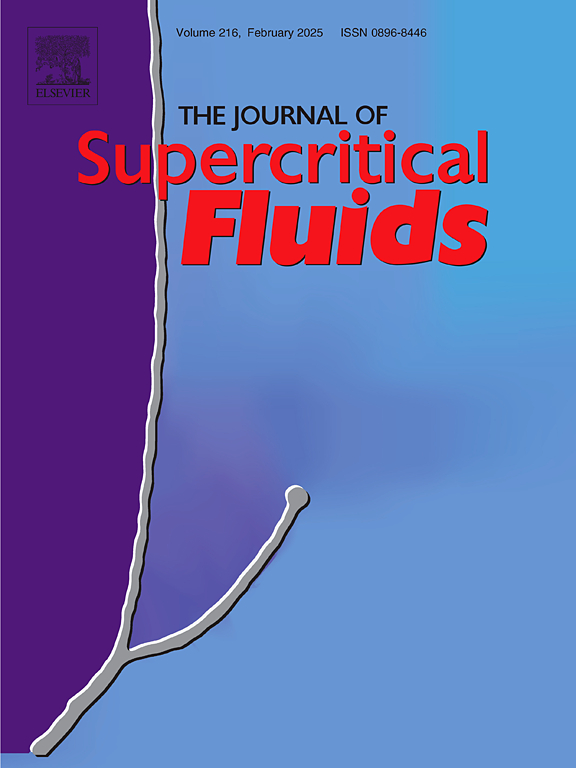Enzymatic ring-opening polymerization of lactones in supercritical carbon dioxide: A review
IF 3.4
3区 工程技术
Q2 CHEMISTRY, PHYSICAL
引用次数: 0
Abstract
The polymerization of lactones has revealed the potential of polylactones for preparing biomaterials with attractive properties for biomedical applications. The use of green solvents and biocatalysts are fundamental steps towards the circularity of the synthesis of these polymers. Supercritical carbon dioxide has emerged as a green solvent for a variety of processes due to its hybrid liquid-gas properties, non-toxicity, and reusability. Novozym® 435 is the most widely used enzyme due to its excellent stability under high pressure. However, the high cost of this lipase is one of the limiting factors for its expansion to an industrial scale. The enzymatic polymerization of lactones in supercritical carbon dioxide is a promising technique for the production of high molar mass polyesters, although it presents challenges in becoming a completely green process. Thus, this work aims to provide an overview of the enzymatic polymerization of lactones in supercritical carbon dioxide, including the compilation and discussion of the developed research up to date. This review also presents the main challenges to overcome for the progress of this technology. In the future perspective, searching for cheaper enzymes and the development of an integrated process that allows the reuse of both the enzyme and CO2 should be part of the research in the coming years. Furthermore, the synthesis of copolyesters employing this biosynthetic route is also a field to be explored, since the easy manipulation of the reaction conditions can offer a wider range of customized polymeric materials.
超临界二氧化碳催化内酯开环聚合研究进展
内酯的聚合揭示了聚内酯在制备生物医学应用中具有吸引力的生物材料方面的潜力。绿色溶剂和生物催化剂的使用是实现这些聚合物合成循环的基本步骤。超临界二氧化碳因其液气混合特性、无毒性和可重复使用而成为各种工艺的绿色溶剂。Novozym®435因其在高压下的优异稳定性而成为应用最广泛的酶。然而,这种脂肪酶的高成本是限制其扩大到工业规模的因素之一。在超临界二氧化碳中酶法聚合内酯是生产高摩尔质量聚酯的一种很有前途的技术,尽管它在成为一个完全绿色的过程中存在挑战。因此,本工作旨在概述超临界二氧化碳中酶促内酯聚合,包括对最新研究进展的汇编和讨论。本文还介绍了该技术发展需要克服的主要挑战。从未来的角度来看,寻找更便宜的酶和开发一种允许酶和二氧化碳重复使用的综合过程应该是未来几年研究的一部分。此外,利用这种生物合成途径合成共聚酯也是一个有待探索的领域,因为易于操作的反应条件可以提供更广泛的定制聚合物材料。
本文章由计算机程序翻译,如有差异,请以英文原文为准。
求助全文
约1分钟内获得全文
求助全文
来源期刊

Journal of Supercritical Fluids
工程技术-工程:化工
CiteScore
7.60
自引率
10.30%
发文量
236
审稿时长
56 days
期刊介绍:
The Journal of Supercritical Fluids is an international journal devoted to the fundamental and applied aspects of supercritical fluids and processes. Its aim is to provide a focused platform for academic and industrial researchers to report their findings and to have ready access to the advances in this rapidly growing field. Its coverage is multidisciplinary and includes both basic and applied topics.
Thermodynamics and phase equilibria, reaction kinetics and rate processes, thermal and transport properties, and all topics related to processing such as separations (extraction, fractionation, purification, chromatography) nucleation and impregnation are within the scope. Accounts of specific engineering applications such as those encountered in food, fuel, natural products, minerals, pharmaceuticals and polymer industries are included. Topics related to high pressure equipment design, analytical techniques, sensors, and process control methodologies are also within the scope of the journal.
 求助内容:
求助内容: 应助结果提醒方式:
应助结果提醒方式:


